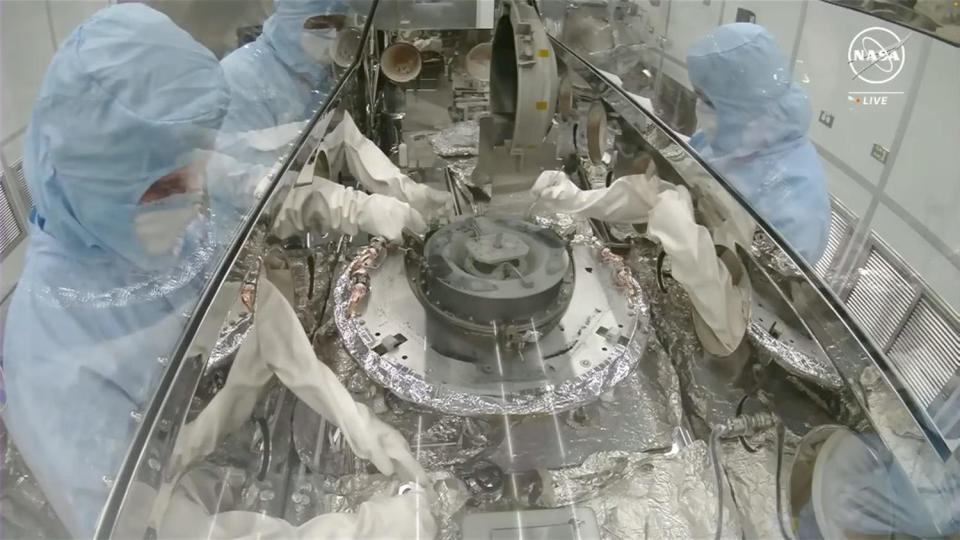Rocks and soil Collected from the asteroid Bennu Planets returned to Earth by NASA’s OSIRIS-REx probe last month are rich in carbon and contain water-bearing clay minerals dating back to the birth of the solar system, scientists said Wednesday. This discovery gives insight into the formation of our planet and supports theories about how water reached Earth in the distant past.
Dante Lauretta, a planetary scientist at the University of Arizona and the principal investigator on the asteroid sample return mission, said the clay minerals “contain water trapped within their crystalline structure,” as he revealed initial images of the material.
“And I want to stop and think about what that means,” Loretta said. “This is how we think water got to Earth.”
“The reason Earth is a habitable world, and that we have oceans and lakes and rivers and rain, is that these clay minerals like the ones we see from Bennu landed on Earth four and a half billion years ago, making our world habitable,” Loretta said.
“So we see the way water was…eventually incorporated into planets.”
OSIRIS-REx sample return capsule Landed in Utah On September 24, nearly three years after the spacecraft briefly propelled its innovative tactile sample acquisition mechanism, Or Tagsamon the surface of the asteroid Bennu, which is filled with debris.
Researchers originally expected TAGSAM to be open by now, revealing the half-pound or so of material estimated to be trapped inside. But they were surprised to find dust and small fragments of Bennu scattered around the interior of the sample return capsule, just outside TAGSAM.
The process of opening TAGSAM was put on hold while scientists eagerly examined the unexpected extra material, which turned out to provide a tantalizing glimpse of the discoveries to come.
“It’s been slow and subtle, but the science has really started,” said Loretta, a planetary scientist at the University of Arizona. “This is a scientific treasure.”
The samples are being studied inside an environmentally isolated laboratory at the Space Center in Texas, where Apollo moon samples are also kept protectively. Initial examination of the asteroid dust with a powerful electron microscope revealed water-bearing clay minerals, sulfides, and high concentrations of carbon.
Along with carbon compounds and clays, sulfides are “a critical component of planetary evolution,” Lauretta said. “It determines how quickly things dissolve, which is also crucial to biology. A lot of the amino acids that give structure to our proteins use sulfur to link and provide those bridges.”

NASA Administrator Bill Nelson said that the Bennu samples captured represent “the largest carbon-rich asteroid sample ever returned to Earth.”
“Carbon and water molecules are exactly the types of materials we wanted to find,” he said. “They are crucial elements in the formation of our planet, and will help us determine the origin of elements that can lead to life.”
Once TAGSAM is open and the entire sample is classified, about 25% of it will be reserved for study by the OSIRIS-REx team at the Johnson Space Center. Another 4% will be shared with the Canadian Space Agency, which supplied the OSIRIS-REx laser altimeter, and about 0.5% will be given to the Japan Aerospace Exploration Agency.
A small portion of the material will be stored protectively at a facility in White Sands, New Mexico, and the rest will be organized for eventual analysis by scientists around the world.
Loretta said the samples detected on Wednesday were “the material that leaked out of TAGSAM when we turned it over.” “Under that cover, there’s a whole treasure trove of material. And trust me, the sample science team can’t wait to get their hands on it.”
Equipped with three cameras, two spectrometers, a laser altimeter, an X-ray imaging system developed by university students, the OSIRIS-REx spacecraft, and a sample return capsule. Launched Atop a United Launch Alliance Atlas 5 rocket from Cape Canaveral on September 8, 2016.
the The spacecraft has reached Bennu In December 2018, it slid into orbit around the 1,500-foot-wide asteroid for several months of mapping and analysis. Nearly two years later, on October 20, 2020, the spacecraft moved into place TAGSAM rammed into the surface.
The collector, which was shaped like an inverted pancake, released a jet of nitrogen gas to stir the soil beneath it at the moment of contact. As the gas exits through the vents, small rocks and soil particles are captured in the filters.

After retracting, OSIRIS-REx’s robotic arm deposited the capture device into an aerodynamic sample return container that was finally returned to Earth last month. The sample container was then transported from Utah to the Astronomical Materials Acquisition and Processing Office at Johnson Space Center for two years of detailed analysis.
A key element of the OSIRIS-REx mission — short for Origins, Spectral Interpretation, Resource Identification, and Security-Regolith Explorer — is to learn more about the materials present at the birth of the solar system 4.5 billion years ago and how they were formed. They combined to form the sun and its retinue of planets.
The formation and evolution of asteroids and comets is key to understanding the source of water in Earth’s oceans and even how life emerged from organic compounds and other chemicals transported to Earth.
A more realistic reason to study asteroids and comets is the risk of potential impacts on Earth such as the Tunguska event of 1908, when an object 200 to 620 feet across exploded in the atmosphere over western Russia, flattening trees over an area of 770 square miles. .
One of the goals of the OSIRIS-REx mission is to understand Bennu’s composition and structure to get a better idea of what might do best to keep a similar object away from a collision course with Earth.
NASA says a sample of the asteroid Bennu shows evidence of water and carbon
House Republicans nominate Steve Scalise to be next speaker
Thousands participate in the funeral of a woman killed by Hamas at a music festival

“Infuriatingly humble alcohol fanatic. Unapologetic beer practitioner. Analyst.”
